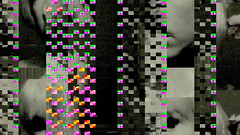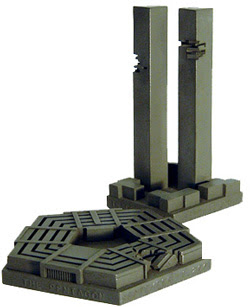A couple of days ago Evan Meaney wrote a blog post titled "Glitching vs. Processing vs. Moshing vs. Signal Interference". I really appreciate Evan's glitch work, from "Ceibas Cycle" to his writings in "on glitching", where he describes the inevitable collaboration with information theory present in all digital work. But this most recent post just doesn't make any sense.
He states that the post is inspired by the diverse work submitted to GLI.TC/H. I can understand wanting to make some loose categories to help group submissions, but the language in the post sounds like he's building a framework. He asks readers to "use this space as a means to explore and delineate, to observe and report, to enumerate...". But it's hard to do that with just four independent categories (with names like "glitching" and "processing") with no unifying structure other than the context of visual arts.
I think I understand where Evan is coming from, so I'd like to try again.
Let's start with noise.
Noise is what happens when we don't understand something. Noise can be manifest in any media: confusion about the clothing of a particular culture, inability to separate a visual foreground from background, the misunderstanding of a foreign rhythm or melody as arrhythmic or atonal. In our failure to contextualize, we create noise.
Glitch means finding noise when we expect to understand. Glitch is an experience, driven by expectation, emerging from consciousness rather than computation. Just as noise would not exist without us to misunderstand it, glitch would not exist without us to misexpect it.
Glitch art is about dwelling in and exploring these experiences, which sometimes means attempting to reproduce them. These reproductions may be executed in a variety of ways. Sometimes it will involve imitating the processes that regularly lead to glitches. This includes direct memory corruption at the byte level, redirection of streams, removal of key frames, analog interference, and circuit bending. Other times it eschews these processes, and opts to evoke the sensation by other means: through the "Bad TV" effect, or in the choice of palette, shapes, motion, melody, etc.
Most of the time, glitch art falls somewhere in between, drawing on the processes that give rise to glitches, but ultimately focused on evoking the experience by whatever means necessary.
Evan suggests that "a true glitch is not reproducible". I believe "true" glitch is unrelated to reproducibility. "True" glitch is tied solely to expectation. The reason it seems like something "stable" is no longer a glitch is simply because it's packaged as such (i.e., a "glitch") removing the possibility of expecting anything else.
That said, acknowledging that glitch is an experience gives us freedom as artists to share that experience regardless of the procedural purity of our practice. Saying that we're just "imperfect" is a cop-out based on a misguided understanding of what glitch artists are aiming for.








